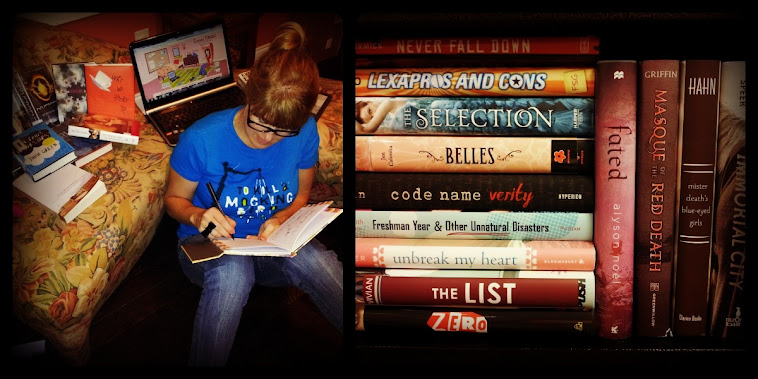Tilt – Ellen Hopkins
Every school has students who are meant for Ellen Hopkins' books, and interestingly, it’s not necessarily the kind of kids you find on the pages of Ellen Hopkins' books - at least not at my school. While Hopkins’ teens may use and abuse drugs, have promiscuous sex, self-mutilate, attempt suicide, succeed at suicide, and suffer physical and emotional abuse – and goodness knows there are teens at my school who this certainly applies to! – there’s also that group of teens who will honestly tell you, these issues are not a part of their lives, they’re just attracted to edgy, dark stories...and Hopkins KNOWS her edgy and dark. Her books may be for and about the messed up kids of the world, but as proof of her wide appeal, you don’t have to come from a messed up home to relate to and feel for those kids who do. Take Tilt, for example…

Mikayla believes she’s found her forever and always in Dylan. He makes her feel special and loved, and they have fun partying together with each other and their friends. Things are perfect really, until her parents find out they’re having sex and forbid them to see each other. Like, really? Mikayla and Dylan are seniors in high school and old enough to know what real love is and how to express that love, so how ridiculous of her parents to try and stop them. That’s okay, though. Mik is smart. She knows how to play the role of perfect daughter and go study with a friend for a test, while she hooks up with Dylan on the side. Parents are sooooo stupid to think they can control their kids, but then Mikayla learns about lack of control the hard way when she and Dylan skip using condoms a couple of times and Mikayla ends up pregnant…and her world tilts.
Shane is gay. He knows it. His mom knows it. His dad knows it. It’s the least of his mom’s worries, though, since she is all-consumed with taking care of his 4-year-old sister, Shelby, who is slowly and surely dying of SMA, a disease that causes her spinal muscles to atrophy to the point she’ll never walk, talk or sit up. A son who’s gay is a walk through the park compared to that! Shane may live in a house of sickness and sadness, but he works hard to keep his spirits up, and meeting and falling for his first ever boyfriend, Alex, sends him soaring. Alex is everything Shane could ever want in a boyfriend – smart, funny, cute, compassionate to his family situation – but there’s just one thing. Alex reveals to Shane he’s living with HIV…and Shane’s world tilts.
Harley is your typical 13-going-on-30 teenager. Her middle school years have been spent living in the shadow of her more attractive best friend, Bri. It’s not that Harley begrudges Bri her looks, she just wants boys to notice her too. When her divorced dad starts seeing a woman with an exceptionally hot son named Chad, Harley determines to do whatever it takes to slim down and get a rockin’ bod. She diets, starts exercising regularly, learns how to apply some heavy make-up, and whaddya know? One of Chad’s friends – well, drug buddies – takes notice. Lucas starts chatting her up, encouraging her to try new things, like weed, and new experiences, like sexting photos of herself. Smart, he never pushes her too far or too fast, and as Lucas readily admits, pursuing the Virgin is half of the fun. It’ll make closing the deal that much sweeter. Harley knows she doesn’t really like Lucas that much, but she just can’t resist the attention from a boy and being made to feel pretty and how good it feels when he touches her …and so her world tilts.
Tilt is based on Hopkins’ adult book, Triangles, which focused on the stories of the parents. Here, the teens of Triangles get their turn, and fans of Hopkins won’t be able to resist. What’s more, it’s easy to overlook the skill it takes to successfully sustain the free verse format over so many stories and books. There were times I’d stop reading Tilt just to take a moment and reread a passage and appreciate the human heart that beats behind her character’s poetic language…
Shelby
I Hear
nobody thinks so. But I do.
Sometimes people whisper.
Sometimes they yell.
Sometimes they say mean things.
I see
more than the TV. It’s my friend.
I don’t have any others, like the kids
on Barney do. Why are people afraid
of me? I don’t want to hurt them.
I taste
only the sweet air, whooshed
through the tubes to help me breathe.
If I’m lucky a bit of flavor comes
with the wind or skin or clothes
I smell.
I wish my mouth would let
me tell Mama I love her.
Let me tell Daddy I miss him.
Let me tell Shane how good
I feel
when I see him happy with Alex
I like when I swim because when
I float, I am free. I like when I sleep
because I dance when
I dream.
-copyright 2012, from Tilt
Okay, so I’m going to give you a moment to clear that lump out of your throat and wipe away that tear…while I do the same.
Hopkins (http://ellenhopkins.com/) will be one of the featured authors at this year’s YallFest in Charleston, SC. She’s also one of the main reasons many of my students have chosen to go on the field trip we’ll be taking to the festival - they are dying to meet one of their all-time favorite authors. Hope she’s got her autographing hand ready!




